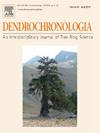Evaluating the influence of high-resolution image capture on the signal strength of blue intensity and quantitative wood anatomy metrics from whitebark pine
IF 2.7
3区 农林科学
Q1 FORESTRY
引用次数: 0
Abstract
Ring-density parameters, such as maximum latewood density (MXD), blue intensity (BI), and quantitative wood anatomy (QWA), can be highly sensitive to summer temperatures. While MXD is traditionally obtained through resource-intensive X-ray densitometry, advancements in high-resolution image processing offer alternative methods for measuring density metrics. This study evaluates latewood BI (LWBI) chronologies developed from two image resolutions (Epson: 2400 dpi and Skippy: 6700 dpi) against QWA-derived MXD (aMXD) for whitebark pine (Pinus albicaulis, PIAL) in the Greater Yellowstone Ecoregion, USA. LWBI metrics exhibited robust linear relationships with June–August (JJA) maximum temperatures (i.e., R2 = 0.27 for Epson and R2 = 0.31 for Skippy; p < 0.01), but differences between image resolutions were not statistically significant. Spatial relationships were robust for LWBI, though the relationships with Epson and Skippy were similar. Additionally, Skippy may have captured a longer growing season signal (June–September) compared with Epson, while Epson improved with selections of a larger fraction of darkest pixels (e.g., 30–50 %). Our findings also indicate that% darkest pixel selections affect outcomes differently when measuring LWBI from Epson and Skippy images. This pilot study highlights the potential of LWBI as a faster alternative to QWA, with both metrics demonstrating significant climate sensitivity in PIAL. By successfully capturing strong temperature signals from PIAL, an understudied and ecologically critical species, this research supports the fusion of dendroclimatological applications to produce a more robust climate signal, as well as the development of millennial-length climate reconstructions in high-elevation ecosystems of North America.
评估高分辨率图像捕获对白皮松蓝色强度信号强度和定量木材解剖指标的影响
环密度参数,如最大后期木材密度(MXD)、蓝色强度(BI)和定量木材解剖(QWA),对夏季温度非常敏感。虽然MXD传统上是通过资源密集型x射线密度测量获得的,但高分辨率图像处理的进步为测量密度指标提供了替代方法。本研究利用两种图像分辨率(Epson: 2400 dpi和Skippy: 6700 dpi)对美国大黄石生态区内白皮松(Pinus albicaulis, PIAL)的qwa衍生MXD (aMXD)进行了评估。LWBI指标与6 - 8月(JJA)最高气温呈良好的线性关系(Epson R2 = 0.27, Skippy R2 = 0.31;P <; 0.01),但图像分辨率之间差异无统计学意义。尽管与Epson和Skippy的关系相似,但LWBI的空间关系是稳健的。此外,与爱普生相比,Skippy可能捕获了更长的生长季节信号(6月至9月),而爱普生则通过选择更大比例的最暗像素(例如30 - 50% %)进行了改进。我们的研究结果还表明,在测量Epson和Skippy图像的LWBI时,%最暗像素选择对结果的影响是不同的。这项试点研究强调了LWBI作为QWA更快替代方案的潜力,这两个指标都显示了PIAL的显著气候敏感性。通过成功捕获PIAL(一种未被充分研究的生态关键物种)的强温度信号,本研究支持了树木气候学应用的融合,以产生更强大的气候信号,以及北美高海拔生态系统千年气候重建的发展。
本文章由计算机程序翻译,如有差异,请以英文原文为准。
求助全文
约1分钟内获得全文
求助全文
来源期刊

Dendrochronologia
FORESTRY-GEOGRAPHY, PHYSICAL
CiteScore
5.50
自引率
13.30%
发文量
82
审稿时长
22.8 weeks
期刊介绍:
Dendrochronologia is a peer-reviewed international scholarly journal that presents high-quality research related to growth rings of woody plants, i.e., trees and shrubs, and the application of tree-ring studies.
The areas covered by the journal include, but are not limited to:
Archaeology
Botany
Climatology
Ecology
Forestry
Geology
Hydrology
Original research articles, reviews, communications, technical notes and personal notes are considered for publication.
 求助内容:
求助内容: 应助结果提醒方式:
应助结果提醒方式:


